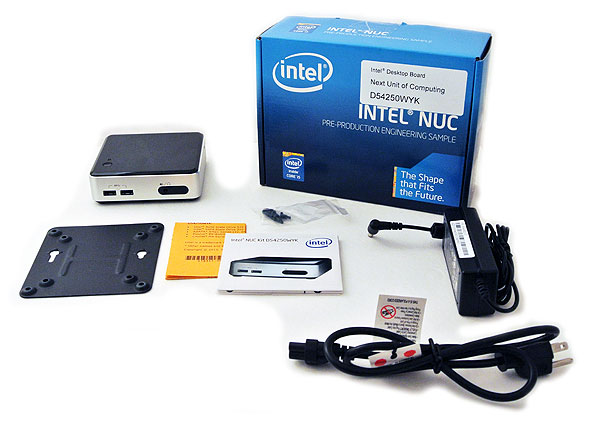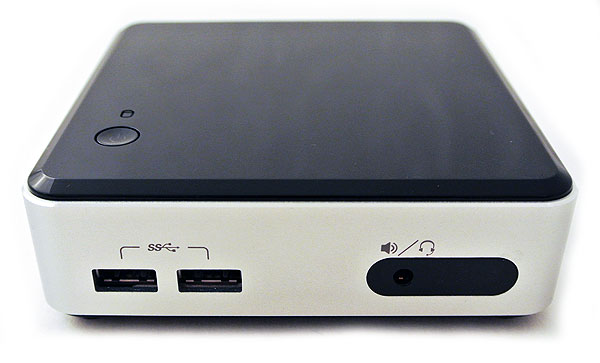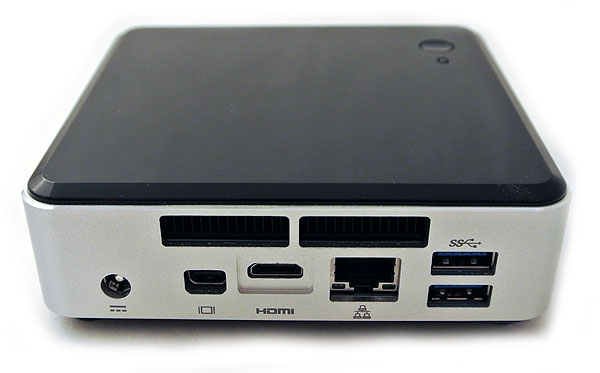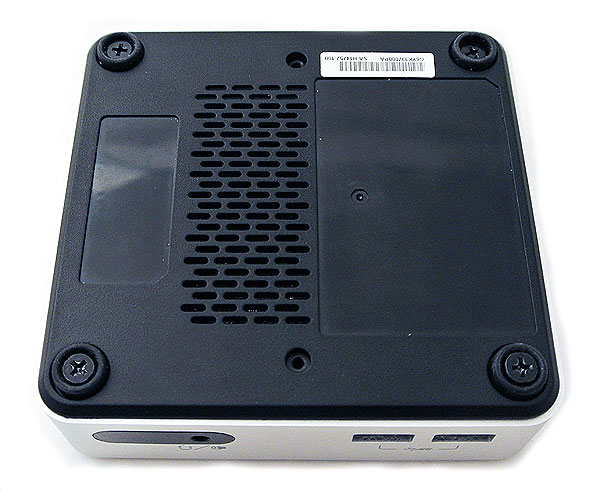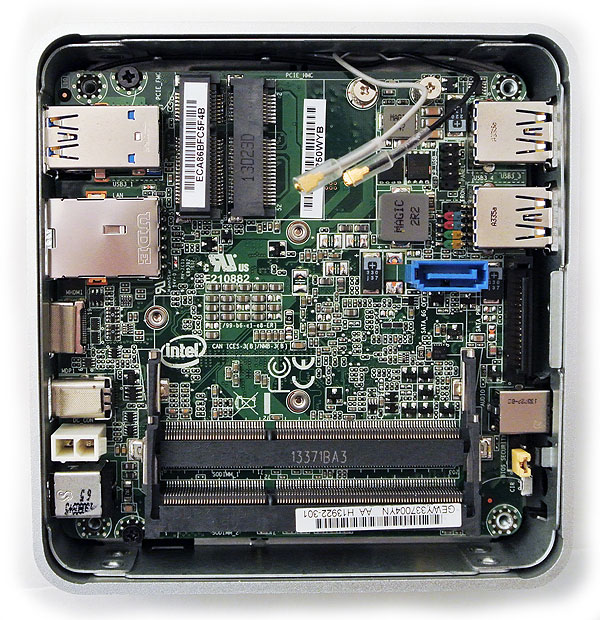Seven Small (But Powerful) Mini-PCs, Reviewed
Intel NUC D54250WYK (Haswell)
Why you can trust Tom's Hardware
While the previous-gen NUC was limited to a 1.8 GHz Core i3, the Haswell-based models can be quite a bit quicker. The D54250WYK comes with a Core i5-4250U operating at 1.3 GHz. It spins up to 2.6 GHz under the right thermal conditions thanks to Turbo Boost, though. More important, it features Intel's HD Graphics 5000, yielding a big step up in mainstream gaming potential.
Newegg has the model listed for $375, though it's currently not in stock. Amazon does have the NUC available, albeit priced in excess of $400. And again, this is a barebones kit, so you still need memory, a Wi-Fi module, and an mSATA-based SSD. Adding Windows 8.1 Professional, Intel's SSD 525 180 GB, and 8 GB of DDR3 from Corair raises the total to $833.97, which is more than twice what you pay for the kit.
Bundle And First Impression
You would think that Intel received enough feedback from its NUC launch a year ago to start bundling a power cable. We talked to the company at CES 2014, and it does in fact plan to start including a cable. But the Haswell-based unit we have for review still doesn't come with one. For now, that cable you see in the picture above has to be purchased separately. The barebones kit comes with an AC adapter, a VESA mounting plate, documentation and, of course, the NUC, though.
I can't imagine anyone complaining about the size of Intel's first effort. It immediately impressed us with compact dimensions and very capable internals. However, Intel took about 15% of the D54250WYK's height compared to the Ivy Bridge-based models. At 4.6" x 4.4" x 1.4" and 1.05 lbs, the weight is down a bit as well. The metal sides are no longer the same color as the top; now they're silver. But the basic design remains the same. At the end of the day, it looks like Intel took a bit of direction from Zotac's Zbox Nano.
The front of the newer NUC sports more connectivity than last generation's. It offers two USB 3.0 ports, a combo input/output audio jack, and an IR sensor for your media center remote (purchased separately).
Around back you find the power connection, mini-DP output, a mini-HDMI interface, GbE networking, and two more USB 3.0 ports.
The interior looks a lot like the previous-gen NUC, except for the addition of SATA and the same as the original NUC with the addition of a SATA port that can't really be used anyway due to this unit's enclosure. By building it onto the motherboard, though, Intel paves the way for slightly taller configurations with room for a 2.5" hard drive or SSD. You still get two SO-DIMM memory slots on one side of the board and two mini-PCIe interfaces (one with mSATA drive support) on the other.
Once again, we know that Haswell-based mobile processors don't work with 1.5 V DDR3 memory. You need to make sure you seek out 1.35 V DDR3L to use with this platform.
Special Features And Livability
The D54250WYK is an evolved NUC. It's smaller than its predecessor with more functionality. Intel's prior effort lacked audio I/O, so that was added. The IR sensor is new too. We find a lot more ports to accommodate external peripherals. Without question, the new NUC is much more desirable than the Ivy Bridge-based version.
| Header Cell - Column 0 | Intel NUC D54250WYK (Haswell) |
|---|---|
| Chipset | Intel QS77 Express |
| CPU | Intel Core i5-4250U, Dual-Core, Hyper-Threaded, 1.3 GHz (2.6 GHz Peak Turbo Boost), 3 MB L3 Cache |
| Graphics | Intel HD Graphics 5000, 200 MHz - 1 GHz |
| Graphics Memory | Shared with system memory |
| System Memory | Not Included |
| Hard Drive | Not Included |
| Optical Drive | N/A |
| Operating System | Not Included |
| Included Peripherals | Not Included |
| Internal Interfaces | |
| Memory Support | Dual-Channel, 2 x DDR3L SO-DIMM slots, 1.35 V, 1333/1600 MT/s, 16 GB Max |
| Mini-PCIe | One slot |
| mSATA | One slot |
| Mass Storage Controllers | |
| Chipset SATA | 1 x SATA 3Gb/s (no space for 2.5" hard drive)1 x mSATA 6Gb/s |
| I/O Panel Connectors | |
| DVI | Not Included |
| VGA | Not Included |
| HDMI | 1 (mini-HDMI) |
| DisplayPort | 1 (mini-DP) |
| Thunderbolt | Not Included |
| MHSL Input | Not Included |
| USB (2.0, 3.0, 2.0/eSATA combo) | 4 x USB 3.0 |
| Memory Card Reader | Not Included |
| Network | 1 |
| eSATA | Not Included |
| Digital Audio out | HDMI |
| Analog Audio | One front |
| IR Sensor | Yes |
| Ethernet & Wireless | |
| LAN | Integrated Gigabit |
| Wi-Fi | Not Included |
| Bluetooth | Not Included |
| Audio | |
| HD Audio Codec | Analog: Realtek ALC283HDMI: Intel Display Audio |
| Audio Channels | unavailable |
| Physical Specifications | |
| Size | 116.6 x 112 x 34.5 mm (4.59" x 4.41" x 1.36") |
| Weight | 478 g (1.05 lbs) |
| Price | |
| As tested: $833.97 (with added Windows 8.1 Pro x64, Intel SSD 525 180 GB GB SSD, Intel 7260 Wireless AC card, and 2 x 4 GB Crucial DDR3 SO-DIMMs)Barebone: $375 (Newegg) |
Current page: Intel NUC D54250WYK (Haswell)
Prev Page Intel NUC DC3217IYE (Ivy Bridge) Next Page LGX ML300Get Tom's Hardware's best news and in-depth reviews, straight to your inbox.
Don Woligroski was a former senior hardware editor for Tom's Hardware. He has covered a wide range of PC hardware topics, including CPUs, GPUs, system building, and emerging technologies.
-
outlw6669 Not a single AMD based SFF PC?Reply
I am disappoint, this would be a great area for AMD to show their competitiveness. -
ta152h @outlw6669I built one based on the A6 5200, and it's perfect for what I need it for. It's low power, more than fast enough for what 99% of the people do, quiet, and inexpensive. I'm a little surprised they didn't choose something based on the Jaguar for that reason, but it might just be a situation where nothing with one was sent to them for review. Certainly this is a poor representation, without both Jaguar and Bay Trail missing. I got to the first page, read what they had, looked at the cases, and moved on. Reading about different versions of Ivy Bridge and Haswell and how they compare to each other is profoundly uninteresting.Reply -
m32 I wouldn't mind having a small system like this. Maybe Mid-Year when everyone's CPU/APUs are out, I'll have the chance to make a smart buy. Thanks for the article. :)Reply -
mesab66 It is interesting that by going slightly larger with the enclosure space (still keeping within cube/rectangle/media player shape) opens up the possibility of so much more power....dedicated gfx, full cpu, etc etc., and, can be cheaper to build - depending on the users requirements.......of course, at the cost of power requirements, etc. I'm thinking most folk would ideally chose a slightly larger form factor for living room/media pc duties.On the other hand, if constraints are tight (form factor in this article) and the end user's requirements match, then these options are worth considering.Reply -
s997863 Power. I don't care about no power. Where's the love for the old games? If I want to play some of the classics which just don't emulate properly, I have to hunt for a heavy old Pentium3 box and try to get it working. How about a cheap mini PC with miniaturized legacy hardware for full compatibility to dual-boot win98 & XP, with gameports, VGA & S-Video, PS/2 & USB, IDE & SATA external ribbon & power connectors, & a turbo button for choosing between 2 processors 200MHz & 3GHz?Reply -
vertexx I am a huge fan of compact systems. Almost everything I have built has been ITX. But I've had a hard time with the NUC form factor. As a desktop, I think it's actually too small. One of those boxes would get lost on my desk, continuously being pushed around by other clutter. Now, if I had a hutch with an optimally sized cubby, that might be a different story.Reply
VESA mounted on the back of a monitor, these look really clunky, and I'd rather go with an AIO kit using the thin mini-ITX form factor where I have more control over processor choice.
I'd be more excited if this technology and form factor were applied in a more interchangeable system with a standardized GPU socket. I really like what ASRock and Gigabyte have done with their compact systems. They're not as compact, but having something a little more substantial on my desk is a good thing, and they pack a lot of punch. I just wish the standards were developed to allow builders to replicate that feat - pipe dream, I know.
One thing is for sure, AMD needs to develop it's own equivalent of the NUC and thin Mini-ITX. The success of it's Kaveri line I think would be helped out by innovation in form factor. -
axehead15 I think you should compare the Mac Mini to these, that way we can see how it adds up.Reply
